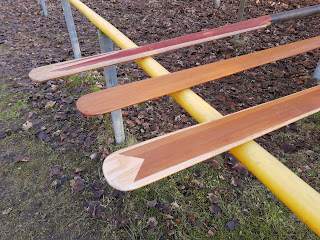In my first period of kayaking I made myself a Aleoetian paddle (AP). This is not a GP because it is not from Greenland but from the Aleoetian islands. However, from a distance they look the same. When you come close you'll see the AP has a ridge on one side. This makes it strong and stiff. I have always assumed the ridge should be on the power side (backwards). This way the blade will not flutter. However, if put to the front, you can make a better use of slicing the blade sidewards for creating lift. The GP's are symmetrical, so without a ridge. Therefore they scull better but they do want to flutter during the forward stroke.
 |
| AP, GP, GP, all made from Red Cedar |
 |
| The right GP has insets of hardwood therefore I name it GP+ |
When I then picked up the GP+ again, it appeared to be a complete different paddle compared to the first time I tested it. It was fun to use and it seems more efficient than the AP, probably because of it's thinner edges and no ridge. My technique has apparently developed somehow during time: I now use some kind of wing-paddle stroke: Pulling the blade sidewards under an angle. This way the blade doesn't flutter and it creates some lift (hopefully).
The GP without insets didn't perform as well as the GP+. I think it is because the edges are more blunt as they are made from really soft wood. I will use this paddle later for some experiments.
On the moment the GP+ is my favorite traditional paddle.
And until the first trip with the Explorer it was my main paddle.
No comments:
Post a Comment